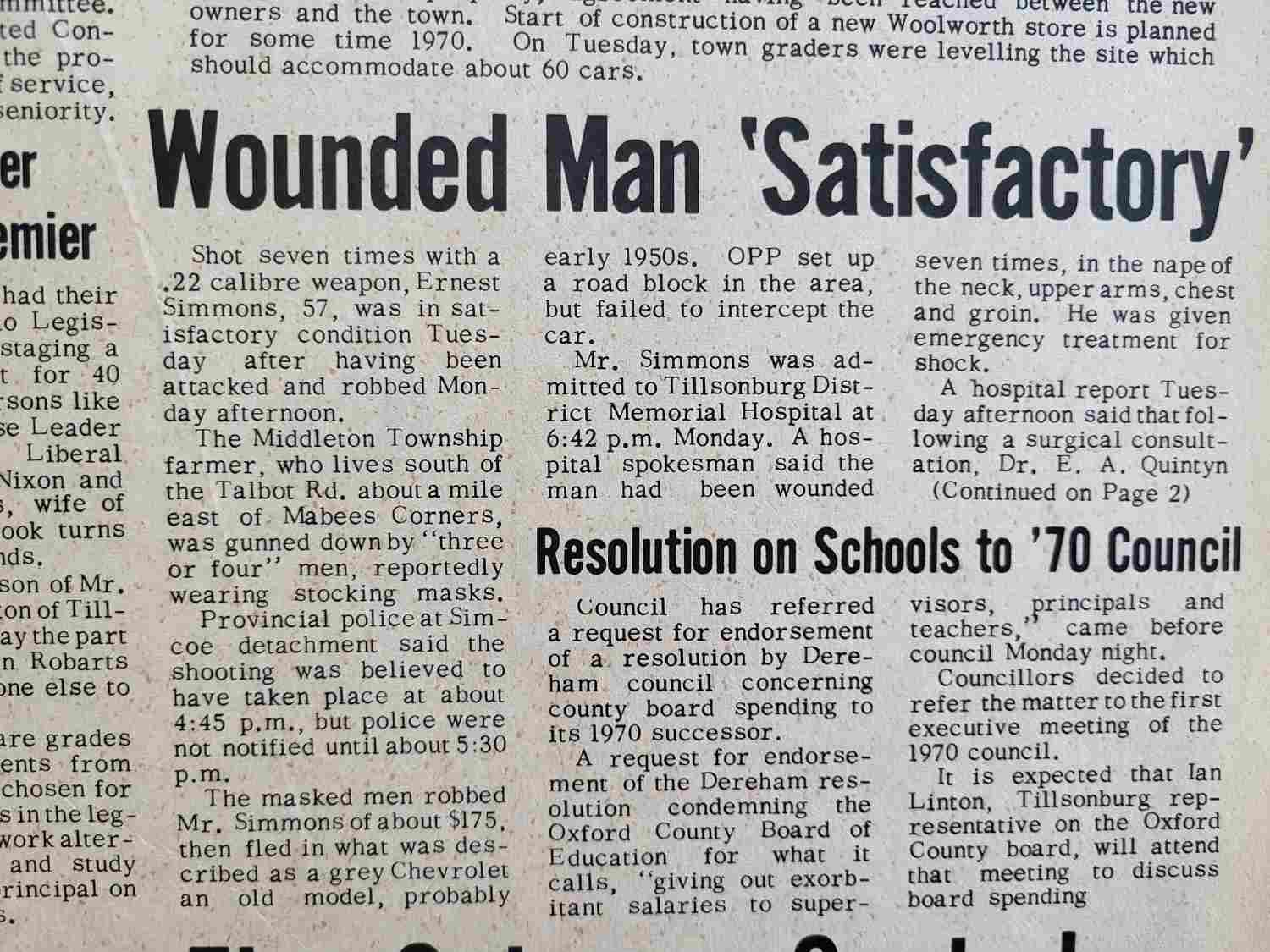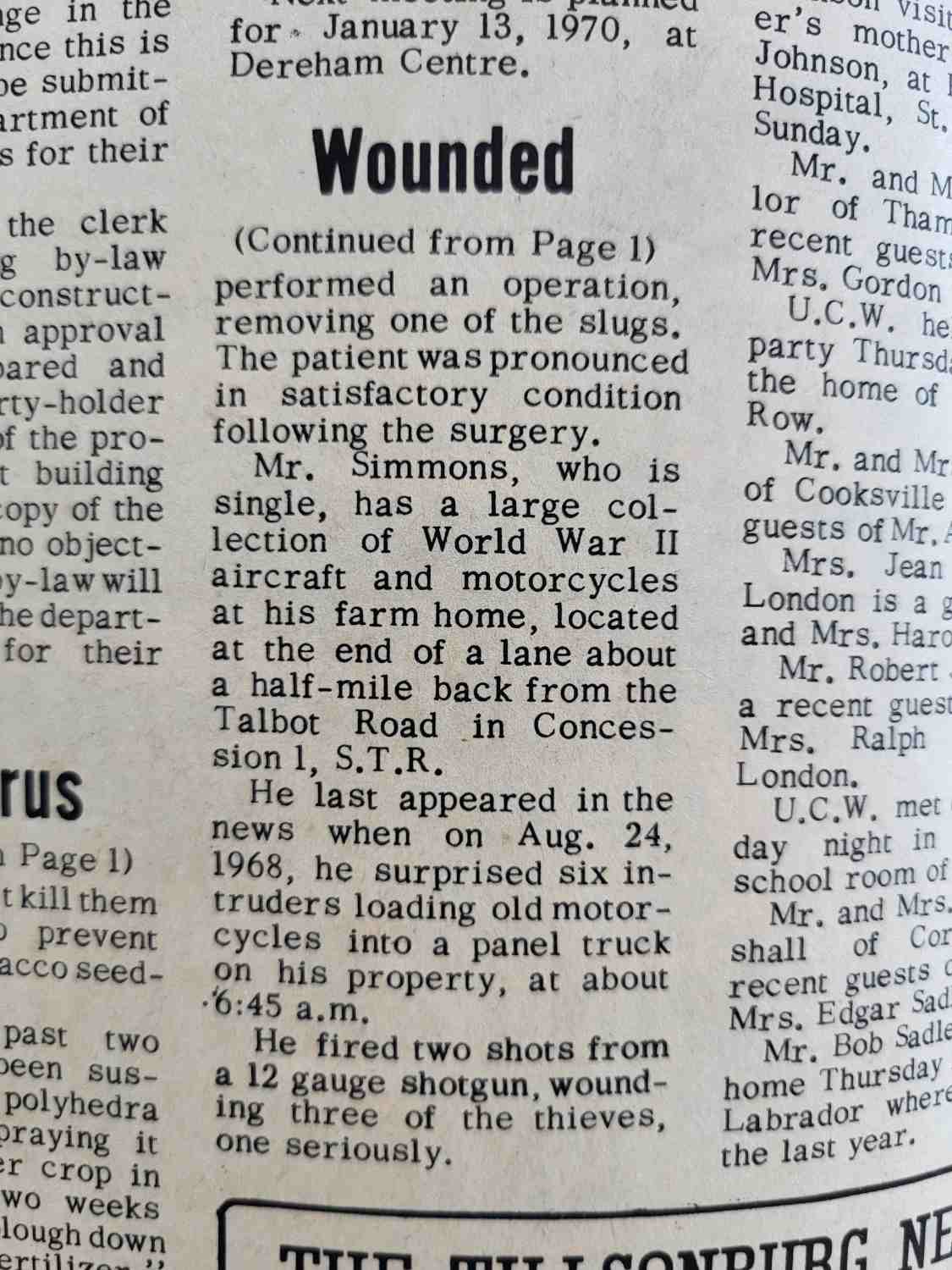Crime Unsolved: The Attempted Murder of Ernie Simmons
Crime Unsolved: The Attempted Murder of Ernie Simmons
By Megan Lockhart, Archives Technician
At around 4:45 p.m. on December 15, 1969, three to four men wearing masks made from women’s stockings broke into the rural house of Ernest V. Simmons, located south of Tillsonburg, Ontario. The men robbed Simmons of a mere $175. When they did not get the big payout they had been expecting they shot Simmons as incentive for him to give up the location of any remaining money or valuables he had in his possession. Having none, the thieves decided to flee with what they had taken and leave Simmons for dead having shot him seven times in total in the nape of his neck, upper arms, chest, and groin. For good measure and to add some extra time for their escape from the crime scene, they cut his telephone line. Miraculously Simmons survived and, despite being in a severely injured state, repaired the phone line to call an ambulance for himself. Why was Simmons targeted? Let’s get into the details.
Ernest (Ernie) Van Simmons was born on a farm south of Tillsonburg in 1912. He spent the entirety if his life there. Ernie was known locally as an eccentric man who largely kept to himself and had a keen interest in vehicles. He made a living by selling cars and car parts that he stored on the farm. After the Second World War, he took advantage of the federal government selling off military vehicles, aircraft, guns, and scrap metal. Simmons also believed that these purchases were an investment, as he thought there would likely be a Third World War and the federal government would be in need of scrap metal to produce weapons and vehicles, of which Simmons had plenty of stored away.
After many years of collecting, it has been estimated that Simmons had 100 motorcycles (from 1917 onward), 14 handguns, 42 shotguns and rifles, dozens of farm tractors, 40 cars and trucks from the 1920s to 1930s, 128 cars from the 1940s to 1960s, 45 planes, and hundreds of airplane parts. Simmons was extremely protective of his property and collection. As a result of this, he lived an isolated life on the farm with his mother and had a number of “booby traps” and defense weapons set up on his property to scare off any trespassers.
As mentioned at the beginning of this article, despite the elaborate defense system for his property, Simmons became the target of a handful of thieves in December of 1969. The men had arrived at his property under the false pretense of wanting to buy auto parts from him, but then forced their way into his house. After managing to survive the dangerous attack, Simmons was hospitalized and the police were notified 45 minutes after the crime took place. They set up a roadblock to try and intercept the thieves’ getaway car but they were already long gone. Simmons stayed only three weeks in the hospital before checking himself out, against the advice of doctors. He was worried about his property being left with no one to watch it as his mother had been moved to the Norfolk General Hospital after the incident as she was suffering from shock.


"The Tillsonburg News", page 2, 16 December 1969.
It was only a week after Simmons returned home that he was sadly found deceased by a friend who visited his house after he had not been able to get in touch with him by telephone. The police were called in to investigate but there was no evidence of foul play and the results of the autopsy showed that Simmons had died of complications from pneumonia. After his death, the investigation into the shooting incident was dropped by police and the culprits were never found.

Front page of "The Tillsonburg News", 19 January 1970.
Having no will or heirs, The Public Trustees of Ontario disposed of and auctioned off the assets on his farm. Auctioneer Dan Murray handled the auction. It was held on Labour Day weekend in 1970, and was a three day long auction. The auction garnered worldwide attention and thousands of people attended. Many of the planes ended up in museums all over North America including:
- The Canadian Warplane Heritage Museum, Mount Hope, ON
- The Pima Air & Space Museum, Arizona, USA
- The Canadian Harvard Aircraft Association, Tillsonburg, ON
- The National Airforce Museum of Canada, Trenton, ON
- The No. 6 RCAF Dunnville Museum, ON
- National Museum of the U.S. Airforce, Dayton, Ohio, USA
- Winnipeg James Armstrong Richardson International Airport, MB
- Reynolds-Alberta Museum, Wetaskiwin, AB
- Canadian War Museum, Ottawa ON
- Smithsonian National Air & Space Museum, Washington D.C., USA
A number of the airplanes also became privately owned and were bought by people from the United Kingdom, the USA (Nevada, California, North Carolina, Missouri, New Mexico, Georgia, Kansas, Michigan, and Texas), Australia, France, and Canada (Guelph, ON, and Peterborough, ON). One of the airplanes was famous for appearing the in the 1942 film “Captains of The Clouds” starring James Cagney.
Sadly, the crime remains unsolved to this day, but the story of Ernie Simmons and his airplanes lives on in the memories of locals in the Tillsonburg area.

The Yale aircraft featured in "Captain of the Clouds" starring James Cagney, courtesy of Wikimedia Commons.
